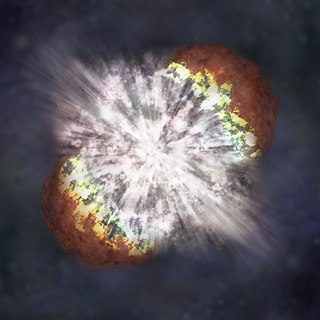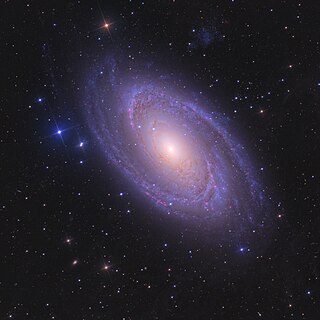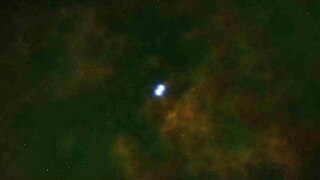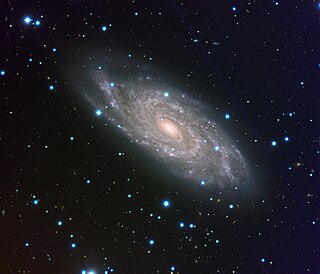
A supernova is an event that occurs upon the death of certain types of stars.

A superluminous supernova, also known as a hypernova, is a type of stellar explosion with a luminosity 10 or more times higher than that of standard supernovae. Like supernovae, SLSNe seem to be produced by several mechanisms, which is readily revealed by their light-curves and spectra. There are multiple models for what conditions may produce an SLSN, including core collapse in particularly massive stars, millisecond magnetars, interaction with circumstellar material, or pair-instability supernovae.

Messier 81 is a spiral galaxy about 12 million light-years away, with at diameter of 90,000 light years, about half the size of the Milky Way, in the constellation Ursa Major. Due to its proximity to Earth, large size, and active galactic nucleus, Messier 81 has been studied extensively by professional astronomers. The galaxy's large size and relatively high brightness also makes it a popular target for amateur astronomers.

Messier 74 is a spiral galaxy in the constellation Pisces. It is at a distance of about 32 million light-years away from Earth. The galaxy contains two clearly defined spiral arms and is therefore used as an archetypal example of a grand design spiral galaxy. The galaxy's low surface brightness makes it the most difficult Messier object for amateur astronomers to observe. However, the relatively large angular size of the galaxy and the galaxy's face-on orientation make it an ideal object for professional astronomers who want to study spiral arm structure and spiral density waves. It is estimated that M74 is home to about 100 billion stars.

A type Ia supernova is a type of supernova that occurs in binary systems in which one of the stars is a white dwarf. The other star can be anything from a giant star to an even smaller white dwarf.

NGC 2207 and IC 2163 are a pair of colliding spiral galaxies about 80 million light-years away in the constellation Canis Major. Both galaxies were discovered by John Herschel in 1835. The larger spiral, NGC 2207, is classified as an intermediate spiral galaxy exhibiting a weak inner ring structure around the central bar. The smaller companion spiral, IC 2163, is classified as a barred spiral galaxy that also exhibits a weak inner ring and an elongated spiral arm that is likely being stretched by tidal forces with the larger companion. Both galaxies contain a vast amount of dust and gas, and are beginning to exhibit enhanced rates of star formation, as seen in infrared images. The collision is of interest because it reflects the probable fate of the Milky Way and Andromeda merger. So far, four supernovae have been observed in NGC 2207:

Type Ib and Type Ic supernovae are categories of supernovae that are caused by the core collapse of massive stars. These stars have shed or been stripped of their outer envelope of hydrogen, and, when compared to the spectrum of Type Ia supernovae, they lack the absorption line of silicon. Compared to Type Ib, Type Ic supernovae are hypothesized to have lost more of their initial envelope, including most of their helium. The two types are usually referred to as stripped core-collapse supernovae.
SN 1999ec is a type Ib supernova that was discovered in the interacting galaxy NGC 2207 on October 2, 1999. It was found on images taken with the Katzman Automatic Imaging Telescope at the Lick Observatory. The progenitor is estimated to have had 38 times the mass of the Sun and was 5.34 million years old at the time of the outburst.
SN 2003H was a supernova that appeared halfway between the colliding NGC 2207 and IC 2163 galaxies. It was discovered on January 8, 2003, by the Lick Observatory and Tenagra Supernova Searches (LOTOSS).

SN 1993J is a supernova observed in the galaxy M81. It was discovered on 28 March 1993 by F. Garcia in Spain. At the time, it was the second-brightest type II supernova observed in the twentieth century behind SN 1987A.
SN 2004GT was a type Ic supernova that happened in the interacting galaxy NGC 4038 on December 12, 2004. The event occurred in a region of condensed matter in the western spiral arm. The progenitor was not identified from older images of the galaxy, and is either a type WC Wolf-Rayet star with a mass over 40 times that of the Sun, or a star 20 to 40 times as massive as the Sun in a binary star system.

NGC 6118 is a grand design spiral galaxy located 83 million light-years away in the constellation Serpens. It measures roughly 110,000 light-years across; about the same as our own galaxy, the Milky Way. Its shape is classified as "SA(s)cd," meaning that it is unbarred and has several rather loosely wound spiral arms. The large numbers of bright bluish knots are active star-forming regions where some very luminous and young stars can be perceived.

Supernova impostors are stellar explosions that appear at first to be a supernova but do not destroy their progenitor stars. As such, they are a class of extra-powerful novae. They are also known as Type V supernovae, Eta Carinae analogs, and giant eruptions of luminous blue variables (LBV).

SN 1994I is a Type Ic supernova discovered on April 2, 1994 in the Whirlpool Galaxy by amateur astronomers Tim Puckett and Jerry Armstrong of the Atlanta Astronomy Club. Type Ic supernova are a rare type of supernova that result from the explosion of a very massive star that has shed its outer layers of hydrogen and helium. The explosion results in a highly luminous burst of radiation that then dims over the course of weeks or months. SN 1994I was a relatively nearby supernova, and provided an important addition to the then small collection of known Type Ic supernova. Very early images were captured of SN 1994I, as two high school students in Oil City, Pennsylvania serendipitously took images of the Whirlpool Galaxy using the 30-inch telescope at Leuschner Observatory on March 31, 1994, which included SN 1994I just after it began to brighten.

NGC 3191 is a barred spiral galaxy in constellation Ursa Major. It is located at a distance of circa 400 million light years from Earth, which, given its apparent dimensions, means that NGC 3191 is about 115,000 light years across. The galaxy has been distorted and interacts with a companion 1.3 armin to the west. An extremely blue tidal bridge lies between them.

NGC 4699 is an intermediate spiral galaxy located in the constellation Virgo. It is located at a distance of circa 65 million light years from Earth, which, given its apparent dimensions, means that NGC 4699 is about 85,000 light years across. It was discovered by William Herschel in 1786.

NGC 7469 is an intermediate spiral galaxy in the constellation of Pegasus. NGC 7469 is located about 200 million light years away from Earth, which means, given its apparent dimensions, that NGC 7469 is approximately 90,000 light years across. It was discovered by William Herschel on November 12, 1784.

NGC 3367 is a barred spiral galaxy located in the constellation Leo. It is located at a distance of circa 120 million light years from Earth, which, given its apparent dimensions, means that NGC 3367 is about 85,000 light years across. It was discovered by William Herschel on March 19, 1784.

NGC 4076 is a spiral galaxy located 290 million light-years away in the constellation Coma Berenices. The galaxy was discovered by astronomer William Herschel on April 27, 1785 and is a member of the NGC 4065 Group.
















